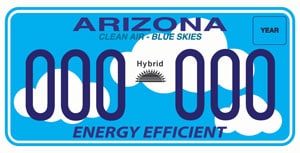Can Ariya, Leaf, and other EV drivers use HOV lanes in Arizona?
One common question owners of electric vehicles like Nissan's Ariya and Leaf have is: Can electric cars use HOV lanes in Arizona? The short answer is yes. For now. There's a federal rule sunsetting at the end of September that will change that.
What are the current AZ HOV rules?
Arizona's HOV (High Occupancy Vehicle) lanes – also known as carpool or diamond lanes – are dedicated priority lanes created to encourage carpooling and reduce freeway congestion during the busiest times of day. Under normal conditions, only vehicles with two or more occupants can use them during rush hours – weekdays 6 a.m.–9 a.m., and 3 p.m.–7 p.m.
Thanks to a provision in federal law (23 U.S.C. 166(b)), Arizona has allowed drivers of alternative fuel vehicles (AFVs), including electric vehicles, CNG, hydrogen, propane, biofuel, and other non-gasoline technologies, to use HOV lanes. It's been a perk of going electric since 2005. As long as their vehicles had the official cloud-style "Blue Sky" AFV license plate, drivers had access to the HOV lanes regardless of the time.

The Arizona Department of Transportation lists vehicles that can use the HOV lanes by priority.
- Passenger vehicles with two or more occupants, including the driver. (That means at least one passenger. Mannikins and pets don't count.)
- Public transit buses.
- Buses with two or more occupants, including the driver.
- Motorcycles.
- Alternative fuel vehicles.
- Specific Low Emission and Energy Efficient Vehicles (existing qualified vehicles only - no new vehicles eligible).
The clock is ticking
Here's the big change on the horizon.
- On Sept. 30, 2025, the federal exemption allowing single‑occupant AFVs in HOV lanes expires.
- Unless Congress extends or amends that law, starting Oct. 1, 2025, solo EV drivers will no longer qualify for EV access during restricted times.
- From then on, HOV lanes will revert to strict two‑or‑more occupant rules, regardless of fuel type.
This means that under the Arizona HOV lane rules, the advantage EV drivers have enjoyed for two decades will disappear. Remember, this is a federal law, so only Congress can change it.
If the AFV exemption in 23 U.S.C. 166 lapses, EV drivers could be cited and fined for driving in HOV lanes during restricted times. And the fine is significant – $400 minimum.
At this point, it's not clear if Congress will extend the AFV provision in the federal law, but we'll keep an eye out for any updates. It might be a good idea to sign up for email or text updates from ADOT; the agency will be among the first to find out anything.
While access to the HOV during restricted hours has been a perk of EV ownership, there are many other reasons to consider an electric vehicle like the Ariya and Leaf.
4 reasons to consider going electric
1. Lower operating costs
Electric vehicles are usually a bit more expensive on the front end, but they save money – lots of it – in the long run.
First, electricity is cheaper than gas, so "filling up" costs significantly less.
Second, there are fewer moving parts, which means fewer breakdowns and less maintenance. EVs don't need oil changes. They have fewer fluids than gas-powered cars. And regenerative braking means less wear and tear on your brakes.All of that translates to more money in your pocket.
2. Better for the environment
EVs like the Leaf and Ariya produce no tailpipe emissions so they do not contribute to air pollution. Let's hear it for clean air!
Because you can charge your EV with solar or other renewable energy sources, you'll reduce your carbon footprint.
3. Charge up at home!
Forget the gas station! You can charge your EV at home without any special equipment. Simply plug it into a standard wall outlet, just like any home appliance. Cut your charge time by plugging into a dedicated Level 2 outlet, which is what your dryer and oven use. Plug in your EV when you go to bed, and in the morning you should have a "full tank."
4. Smooth, quiet performance
If you've ever driven or ridden in an EV, you were probably amazed by how quiet they are. Electric motors are almost silent. And they're as smooth and responsive as they are quiet. Acceleration is almost instantaneous because the engine doesn't have to rev up and there is no gear shifting.
Key takeaway
The key takeaway here is that unless something changes, Arizona EV drivers will not be allowed to use HOV lanes during peak time, effective Oct. 1. If you do, you could be cited and fined at least $400.